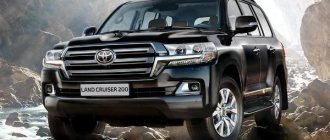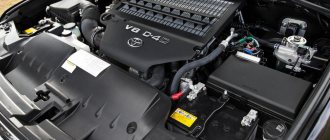The car was first shown back in 1960. This model is the longest-lived of all that are in the arsenal of the Japanese company. Over the years, countless restylings and generational changes have been made. Toyota Land Cruiser has always been very popular in any country to which it was delivered. This is due to high comfort, powerful engines and good cross-country ability of the car.
Land cruiser 200 dimensions
The graphs show the dimensions of the Toyota Land Cruiser 200 Series - width, length and height.
Data is shown for all available modifications, including, for some, the overall width with mirrors. The smallest cars are marked in green, and the largest in red.
Below is a summary table of overall dimensions for all modifications of the Toyota Land Cruiser 200 Series.
The Toyota Land Cruiser 200 frame SUV is sold on the Russian market with two powertrain options: a 4.6-liter gasoline V8 with a power of 309 hp. (439 Nm) and a 4.5-liter V8 turbodiesel with output of 249 hp. (650 Nm). During the 2015 restyling, both engines were brought into compliance with the requirements of the Euro-5 standard. A diesel engine traditionally has a wide “shelf” of peak torque, developed in the range of 1600-2600 rpm. Both powerplants are mated to a 6-speed automatic transmission.
The car's all-wheel drive is a full-time Full-Time with an asymmetrical center differential (with a forced locking function) and a reduction gear. The suspension consists of a double-wishbone front structure and a solid rear axle. To reduce body sway, a KDSS roll suppression system with hydraulically controlled stabilizers is provided.
The naturally aspirated petrol “eight” installed under the hood of an SUV is famous for its remarkable “appetite”, consuming on average about 13.9 liters of fuel per 100 km of travel. The fuel consumption of the Toyota Land Cruiser 200 with a diesel engine is significantly less - 10.2 liters when driving in the combined cycle. Installing a 45-liter tank in addition to the basic 93-liter tank allows you to increase the vehicle's range to an impressive 1,200 km.
Technical characteristics of Toyota Land Cruiser 200:
| Parameter | Land Cruiser 200 4.5 TD 249 hp | Land Cruiser 200 4.6 309 hp |
| Engine | ||
| engine's type | diesel | petrol |
| Injection type | direct | distributed |
| Supercharging | Yes | No |
| Number of cylinders | 8 | |
| Cylinder arrangement | V-shaped | |
| Number of valves per cylinder | 4 | |
| Volume, cubic cm. | 4461 | 4608 |
| Power, hp (at rpm) | 249 (2800-3600) | 309 (5500) |
| Torque, N*m (at rpm) | 650 (1600-2600) | 439 (3400) |
| Transmission | ||
| Drive unit | permanent full | |
| Transmission | 6 automatic transmission | |
| Suspension | ||
| Front suspension type | independent multi-link | |
| Rear suspension type | dependent | |
| Brake system | ||
| Front brakes | ventilated disc | |
| Rear brakes | ventilated disc | |
| Steering | ||
| Amplifier type | hydraulic | |
| Gear ratio | 16.7 | |
| Number of steering revolutions (between extreme points) | 3.1 | |
| Tires and wheels | ||
| Tire size | 285/60 R18 | |
| Disk size | 8.0Jx18 | |
| Fuel | ||
| Fuel type | diesel fuel | AI-95 |
| Environmental class | Euro 5 | |
| Tank volume, l | 93+45 | |
| Fuel consumption | ||
| Urban cycle, l/100 km | 12 | 18.2 |
| Extra-urban cycle, l/100 km | 9.1 | 11.4 |
| Combined cycle, l/100 km | 10.2 | 13.9 |
| dimensions | ||
| Number of seats | 5/7 | |
| Number of doors | 5 | |
| Length, mm | 4950 | |
| Width, mm | 1980 | |
| Height, mm | 1955 | |
| Wheelbase, mm | 2850 | |
| Front wheel track, mm | 1650 | |
| Rear wheel track, mm | 1645 | |
| Front overhang, mm | 925 | |
| Rear overhang, mm | 1175 | |
| Interior dimensions LxWxH, mm | 1965x1640x1200 | |
| Trunk volume, l | 909 | |
| Ground clearance (clearance), mm | 230 | |
| Geometric parameters | ||
| Entry angle, degrees | 32 | |
| Departure angle, degrees | 24 | |
| Ramp angle, degrees | 25 | |
| Angle of slope overcome, degrees | 45 | |
| Tipping angle, degrees | 44 | |
| Fording depth, mm | 700 | |
| Weight | ||
| Curb, kg | 2585-2815 | 2585-2785 |
| Full, kg | 3350 | |
| Maximum trailer weight (equipped with brakes), kg | 3500 | |
| Maximum trailer weight (not equipped with brakes), kg | 750 | |
| Dynamic characteristics | ||
| Maximum speed, km/h | 210 | 195 |
| Acceleration time to 100 km/h, s | — | 8.6 |
00-Land-Cruiser200_zr-01_16
Toyota Land Cruiser 200 4.6 V8 | Toyota Land Cruiser 200 4.5d V8
- Length/width/height/base 4950/1980/1955/2850 mm
- Trunk volume (VDA) 909 l
- Curb/gross weight 2785/3350 kg | 2815/3350 kg
- Acceleration time 0-100 km/h 8.6 sec | n.d.
- Top speed 195 km/h | 210 km/h
- Fuel/fuel reserve AI-95/93 l | DT/93 l
- Fuel consumption: urban/suburban/combined 18.2/11.4/13.9 l/100 km | n.d.
- Engine : petrol, V8, 32 valves, 4608 cm³; 227 kW/309 hp at 5500 rpm; 439 Nm at 3400 rpm | diesel, V8, 32 valves, 4461 cm³; 183 kW/249 hp at 2800–3600 rpm; 650 Nm at 1600–2600 rpm
- Transmission four-wheel drive; A6
“Two Hundred” tensed up a little and pulled the battered Hyundai Accent off the snowy parapet. The men, who had been swinging one shovel between them for hours, breathed a sigh of relief. Toyota's flagship is not just a big car and not a show-off - it is, first of all, a serious all-terrain vehicle. Proven by the snow-covered roads of the Urals.
Was, is and will be
— How can you drive on such roads in production cars? There are no such snowdrifts even in Hokkaido!
The Japanese engineer was shocked. Yes, I am too. Beyond the Ural ridge, the snow became more and more intense every minute, and our chances of getting to the base were fading before our eyes, despite the deepening frost. The Land Cruiser got stuck up to the hub in the snow, but with bullish stubbornness it made its way to the coveted “borrow”. In five hours we covered only a few kilometers, and the speed continued to drop. When it started to get dark, the thought flashed: that’s it, let’s spend the night in the forest!
Engines and transmissions
What is the fuel consumption of the Toyota Land Cruiser Prado: per 100 km in a mixed, urban (in the city) and extra-urban (on the highway) cycle
Most of the Land Cruiser 100 presented on the Russian secondary market are equipped with a 4.7-liter V8 gasoline engine. In addition, 4.2-liter diesel engines were offered for the “hundredth” - naturally aspirated (131 hp) and turbocharged (204 hp). An important nuance: on all versions it is necessary to clean the radiator annually. If this is not done, the engine may overheat, and problems with the air conditioner may also occur. So, gasoline engines on the Land Cruser 100 have proven themselves to be very reliable. Even on cars with mileage of more than 300 thousand km, they did not cause serious problems to the owners. True, exhaust manifolds usually burn out after 100 thousand km. They must be changed along with the gaskets. Each collector costs about $400. The right one is easy to change. And to dismantle the left one, you will have to remove the steering shaft, and then set the camber and toe angles of the front wheels. As a rule, no other troubles happen.
You can only hear positive reviews about atmospheric diesel - it is almost eternal. There are known cars with half a million miles on them, on which the engine at least works as usual. At the same time, it calmly “digests” even diesel fuel of dubious quality. The only necessary condition is to clean the injectors after 35-40 thousand km.
Fuel pumps on the naturally-aspirated diesel engine 1HZ, turbo engine 1HD-T and 24-valve 1HD-FT are all of the same type - Bosch VE. They all equally dislike bad fuel. And the electronically controlled high-pressure fuel pump (type COVEC F) on the 1HD-FTE engine absolutely cannot stand diesel fuel. A bad diet can cause it to suddenly fail. And its replacement... Let's pause... Costs...$6000! We are sure that you no longer want a turbodiesel... In addition, let us remind you: on cars with such a heart, you should change the air and fuel filters in a timely manner, after long-term operation of the engine, let it idle for a minute or two to cool the turbocharger bearings. Many owners neglect these rules. Retribution is inevitable - the turbine of such drivers will not last long. And replacing it will cost at least $3,500. Gearboxes - both automatic and manual - on the Land Cruser 100 are very reliable. Only illiterate off-road driving can finish them off. The clutch lasts at least 200 thousand.
In the transmission, the oil drain pipe (breather) of the rear axle becomes clogged due to frequent off-road driving. As a result, axle shaft seals leak. That’s why good service centers clean the breather every 10,000 km. The cardan shaft crosspieces are injected with the same frequency. Russian owners of VX modifications consider the front axle gearbox to be the weak point. However, employees of branded services accuse the drivers themselves of inability to properly operate the car off-road and unwillingness to at least sometimes read the instructions for the car.
Engine TLC300 V35A-FTS 415 hp. Rule with hope.
That's all, the era of V8 engines under the hoods of Kruzaks is over!
The presentation of the TLC300 confirmed that conservative Toyota abandoned the V8 in favor of a turbocharged V6.
I would like to note that gradually, in less than 15 years, Toyota turned the legendary “millionaire” 2UZ-FE into a disposable engine with a minimum resource.
Disposable - since a major overhaul of this engine is not provided, therefore there will be no repair spare parts on sale, and our craftsmen will have to learn to capitalize on them, fortunately this is not the first time, or buy a new short block (cylinder block with crankshaft and piston assembly) every 200-300 t.km.
A LITTLE HISTORY
In 2007, the 200th Kruzak with a 2UZ-FE engine entered the market. Volume 4.7 liters, all-cast iron block, heavy pistons and thick rings, hydraulic phase regulators only at the inlet, cheap to replace timing belt, simple distributed injection. everything was done to ensure that the engine lived for a long time, even under difficult operating conditions.
In 2011, Kruzak received its first restyling, and with it another 1UR-FE engine with 309 hp. More capricious and less reliable. The cylinder block is aluminum, without cast iron liners, volume is 4.6 liters, timing chain, new lightweight pistons, and thin piston rings, which, by the way, wore out very quickly in metropolitan traffic jams. The owners began to carry a canister of oil in the trunk, you never know when the oil consumption increases significantly and an urgent need to top it up.
And here we are in 2021, a new body is being rolled out to us, with a relatively new engine. V6 turbocharged petrol V35A-FTS. How many thousand will it last? Many cars of this type travel 50-100 t.km. per year, what to do with a three-year-old Kruzak whose engine requires replacement?
What kind of beast is the V35A-FTS?
This engine is a little over 3 years old. It was first installed on the Lexus LC500 sports coupe in 2021. This engine was developed specifically to replace all V8s. And the second model on our market was the TLC300.
The beginning of our era – 80 series
Tuning Toyota Land Cruiser 76 (2011)
Land Cruiser 80
The release of the Toyota Land Cruiser 80 marked the beginning of a new era in Japanese automobile manufacturing. 10 years of model release (1988-1998) became the years of formation of the Toyota brand as we know it today. And not the least role in this was played by the Land Cruiser, which began to offer a variety of engine options.
Until 1992, the gasoline family was represented by a carburetor 4-liter 3F-E unit with 155 horsepower and a 4.5-liter 195-horsepower new 1FZ-F, which was later converted to a fuel-injected 1FZ-FE engine with a power of up to 215 horses. The naturally aspirated 4.2 liter 1HZ has become a legend of the concern. Owners of a car with such a unit argued that the resource of the Toyota Land Cruiser engine cannot be exhausted. 120-136 naturally aspirated horsepower became the favorite of American farmers. There were also 4.2-liter turbocharged diesel engines 1HD-T and 1HD-FT. The power of 170 horsepower was accompanied by unprecedentedly low fuel consumption, but such cars were practically not exported to the CIS countries. Commercial vehicles were equipped with a simple 1PZ engine of 3.5 liters and 115 horses. Land Cruiser Prado was awarded smaller diesel units: 2L-T and 2LT-E 2.4 liters and 85 and 97 horses, respectively, as well as a 3-liter 1KZ-TE with 130 horses.
The eightieth generation of the iconic SUV lasted on the market until 1998, when the design was already obsolete and the engines required updating.
What kind of J105?
Technical characteristics of toyota land cruiser
Naturally, after the car was released, fans immediately began to torment it with off-road conditions. The problem arose at the front - the independent suspension could not stand it. There was a lot of indignation that the car had “slipped” and could not drive like its predecessor.
Toyota quickly got its bearings and released an off-road version of the J105, which returned the front solid axle. Visually, the car differs only in its hinged tailgates. If we consider the technical stuffing, then this is the J80 platform, which has a new body installed.
There is a different (old) frame, an old suspension, but the engines are approximately identical. The interior equipment was also simplified, because a car positioned as a combat vehicle needs various comfort attributes in the form of leather or electrically adjustable seats. “Sores” can be studied in the review of its predecessor.
Toyota Land Cruiser 100 configurations
The Land Cruiser 100 was supplied to Russian buyers in three trim levels.
STD (standard) is a simple, practical version of the Kruzak. There are mechanical windows, seats and floors covered in vinyl, no airbags, ABS, but there is air conditioning. The rear bench doesn't fold flat, and the third row of seats is spartan. Stamped wheels are shod with narrow tires measuring 235/85 R16.
2002 Toyota Lancruiser - Standard
GX is the average configuration of the Land Cruiser 100. In addition to the air conditioner, it has a number of other useful things: electrical accessories, an immobilizer, a radio, and an electric antenna. There are roof rails on the roof, and the interior is upholstered in fabric. The backs of the second row of seats can be adjusted and folded, and the third row has become more comfortable. The “rollers” are cast, shod with 275/75 R16 tires. Options included a sunroof, ABS, winch, and rear disc brakes.
2005 Toyota Land Cruiser 100 GX
VX is the most expensive version of the Land Cruiser 100. Seat upholstery was offered in a choice of leather or velor. The steering wheel and gear lever are trimmed in leather. Among other things, there is a full power package, a climate control system, and alloy wheels with 275/65 R17 tires.
2002 Toyota Land Cruiser 100 VX
Toyota Kruzak 100 after restyling in 2002 received a slightly changed appearance. The standard equipment has become wider, and the luxury equipment has been supplemented with separate climate control for both front and rear passengers, a new instrument panel, and an upgraded steering rack.
Salon of Toyota Land Cruiser 100 after 2 restyling
Engine
Since there are several trim levels of the car, there are also several power units.
The diesel engine is based on previous models. It is equipped with a turbocharger and an air cooler, as well as an electronic injection timing control system. This increased power and torque. The car began to accelerate better. Toyota now does 100 km/h in 13 seconds. Also, with the new engine, diesel consumption per liter has decreased. The power unit managed to surpass the gasoline engine that was installed on the 80s Cruiser models.
Diesel SUVs were imported through “gray” suppliers. There were regularly problems with them, since the Land Cruiser 100 had engine specifications that required a different quality of diesel fuel. Due to the “high quality” of local fuel, fuel injection pumps and injectors especially suffered. But diesel was much more economical. Here the consumption was only 16 liters per 100 km. It is known that until 2002, Land Cruisers were equipped with another diesel engine. The unit was much more powerful than the others, but in Russia it is very rare, just like a regular turbodiesel.
“Sotki”, which were sold by official dealers, were equipped with a V8 gasoline engine. Most of the cars had a 235-horsepower unit with the VX modification under the hood. It had a smooth and very quiet ride, and the car had excellent dynamics. The engine allowed it to accelerate to 100 km in 11.7 seconds. This is a good indicator for a car weighing 2.5 tons. The only disadvantage of this engine is its high consumption: the Land Cruiser 100 “eats” from 18 to 25 l/100 km.
There is also a naturally aspirated diesel engine. It is installed on STD and GX. This is a 6-cylinder engine with a capacity of 130 hp. With. It is not equipped with a turbine, so it is a bit phlegmatic.
Whatever the engine in the “hundred”, they are all quite reliable. The owner only needs to undergo regular scheduled maintenance.
02-Land-Cruiser200_zr-01_16
If desired, Crowl can be disabled - but, as practice has shown, digging will take longer. The function of automatically maintaining a given speed has proven its effectiveness, although at first I did not trust it: I preferred to speed through difficult places, relying on permanent all-wheel drive with a Torsen center differential.
Damn, now I've gone too far with gas! The Land Cruiser was pushed across the road, and the rear bumper was cracked and buried in a tree. While pushing the car out, we left dents on the fifth door from our hands... But the main thing is that we are crawling again! No transmission overheating, no electronic failures. That’s how, meter by meter, the “two hundred”, albeit not without the help of shovels, cables and manpower, delivered us to our destination. In the Ural Mountains, she proved herself to be a professional tool for survival.
What mountains are there! The LC200 is ready to take on Toyota itself. During the crisis year of 2015 on the Russian market, Land Cruiser consistently held almost a 50 percent share in the segment of its own kind. There are fewer and fewer frame-based SUVs, but the LC200 is still making its mark. And he's not going to stop.
PROS : Reputable, roomy, with excellent maneuverability
CONS : Needs at least a couple of USB ports and a central display with more advanced graphics
ECOPLUS
The five-seater petrol car, starting with the Elegance configuration, has an additional 45-liter fuel tank. The filler neck is common, fuel is transferred between tanks automatically. A total of 138 liters of gasoline is enough for 1200 kilometers. There is no second tank on seven-seater versions and diesel versions: with it, the gross vehicle weight would exceed 3.5 tons and the Land Cruiser would fall into the truck category. However, the 1VD-FTV turbodiesel is already very economical. It received a different electronic control unit and a pair of particulate filters, which made it possible not only to reduce fuel consumption and increase power, but also to raise the engine’s environmental class to Euro 5. The latter is important, since environmental standards are being raised in Russia and certification of cars to Euro-4 standards will soon become impossible.
Land Cruiser costs on gas compared to gasoline
Averaged data proves the financial benefits of installing gas equipment using methane. The savings are approximately 15-20%. However, they do not take into account the following factors influencing this indicator:
- congestion on city highways;
- acceleration dynamics;
- ambient temperature;
- engine's type.
But these statistics give a general idea of the financial advantages of gas equipment.
If the car is used infrequently and for short trips, the difference will not be so noticeable. It makes sense to replace a gasoline engine with gas-cylinder equipment only when the vehicle is used intensively. Methane consumption on the Prado is 13 liters per 100 km when driving on the highway.
For comparison, we can cite the standard use of a car with a 4.5 MT power plant and a 96-liter fuel tank. A Land Cruiser running on methane will cover 895 km on city streets without refueling, and 1,508 km on the highway. In the combined cycle, the fuel is enough for 1208 km. Under similar conditions, a car with a gasoline unit will travel:
- in the city – 495 km;
- along the highway – 722 km;
- in combined mode – 578 km.
Real consumption figures
But, as we all know, the data declared by the manufacturer does not remain relevant for long, because during operation you can be surprised to learn that when traveling on a Land Cruiser 200, the consumption is much higher. That is why it is extremely important to find out the real fuel consumption of Land Cruiser 200 diesel and gasoline in order to understand what to prepare for.
The gasoline version requires 20 liters of fuel per 100 km in the city, and on the highway you will have to say goodbye to about 13-15 liters of gasoline, which, of course, is a lot;
The actual consumption of the Land Cruiser 200 diesel is approximately 13-15 liters in city mode, and on the highway it will require more than 10 liters, which is also not so little.
Popular power units and amount of fuel consumed
Toyota Land Cruiser 200 is a popular car, characterized by a wide variety of configurations that relate to both the appearance and technical characteristics of the vehicle. Among all the available engine options, two models stand out the most:
The engine on the Cruiser 200 model 4.5 liter, running on diesel fuel, is distinguished by high power and dynamic LC. The peak power of this model is recorded at 3200 rpm, while it has a built-in turbocharger that promotes rapid cooling. If we talk about the amount of fuel required, then the Land Cruiser 200 model 4.5 liters consumes 10 liters per 100 kilometers
In 9 seconds the car accelerates to 100 km/h, and the maximum speed is limited to 210 kilometers per hour. The second engine, which deserves increased attention, unlike the Cruiser 200 diesel, runs on gasoline. At the same time, this model is considered very uneconomical, because its fuel consumption is 18-20 liters per 100 kilometers in the city. The peak power of such a machine is recorded at 5,500 rpm.
1GD-FTV
This is a 2.8-liter diesel power unit, which has been produced since 2015. The engine is assembled in Japan and installed there in SUVs, pickups, and minibuses. Assembled taking into account modern technologies and environmental standards. Its cylinder block is cast iron (inline-four) and the cylinder head is aluminum 16-valve. The maximum power of the 1GD-FTV is 177-200 horsepower, and the torque reaches 450 Nm. A very powerful and high-torque engine that makes the SUV pull from the very bottom. It is equipped with hydraulic compensators, and a timing chain with a service life of over 150 thousand km is used as a timing drive. Everything would be fine, but the engine is literally tailored to strict environmental standards. There is an EGT valve, a DPF filter, and a DOC filter along with SCR. All this, in theory, can cause headaches for the domestic driver.
It is also worth considering that this engine is equipped with a rather whimsical turbine with variable geometry VGT and VNT. Other features of the motor are ESCTEC and TSWIN. The motor is “stuffed” with modern solutions, which, of course, does not make it reliable. At best, you should count on 250 thousand kilometers. There are already known cases of recall of the Toyota Land Cruiser Prado to change the firmware of the control unit, as car owners complained en masse about a problem with the DPF particulate filter. It’s too early to talk about other shortcomings and problems of the 1GD-FTV, since the engine is still essentially new and the cars have not covered the required mileage for any conclusions to be drawn. Also, many drivers note that even at the very beginning they encountered increased oil consumption. Changing the engine oil helped some.
Constantly growing popularity
From the release of the first Toyota BJ model to the latest versions of the Land Cruiser, the car's popularity has only increased. The introduction of the latest technologies, Japanese meticulousness in the smallest details, quality of assembly and materials - all this gives results.
The popularity of the car in the world is evidenced by the fact that it is easier to find a contract engine for a Toyota Land Cruiser than a unit for any other car.
The quality of the Japanese concern and its attitude to business make Toyota cars a desirable purchase for every person. Let's hope that future generations of the SUV series will be no less attractive in all respects.
Source
Technical characteristics and modifications
When choosing a car, they try to find out as much information as possible about the car and its modifications. Toyota land cruiser 100, 200, as well as other series models are on sale. The latest modification of the Toyota Land Cruiser 200 is the heaviest of all those produced. It has a reliable suspension and brakes, and the roof pillars are made reinforced. The line of engines is represented by power units with a displacement of 4.0; 4.5; 4.6; 4.7; 5.7 liters. These can be either diesel or gasoline engine options.
The Toyota land cruiser 100 model was the predecessor of the 200 series. She also showed herself to be good, but she was very gluttonous. It reached 16 liters per 100 km. Therefore, designers had to work on improving the characteristics of the next generation models. Cars of the next modification already had more improved performance in terms of fuel consumption, power and dynamic characteristics.
Toyota Land Cruiser J70
This model left the factory gates back in 1984 and is still produced in some countries. The following can be said about this car:
- The power unit has a working volume of 4 liters.
- The engine design is a V-shaped six.
- Engine power is 321 hp and torque is 360 Nm.
- The manual transmission has 5 speeds and all-wheel drive is available.
Toyota Land Cruiser 80
It is a powerful SUV capable of providing good cross-country ability and comfort while driving. A powerful frame structure and independent suspension on all wheels are a characteristic feature of this car model. The engine compartment may contain a gasoline or diesel power unit. Gasoline versions of power units can have both a carburetor and an injector in the power system, which is much better and more economical.
The carburetor is a complex structure, and with a significant mileage of the car, repairing it is quite problematic.
Toyota Land Cruiser 100
This all-wheel drive Land Cruiser SUV left the factory gates in 1997, and mass production of the vehicle began the following year. The specific technical characteristics of the car are such that in the engine compartment you can see six modifications of gasoline power units. Their power could be from 205 to 235 hp. engine displacement is from 4.5 to 4.7 liters. Diesel units were available in three versions with a volume of 4.2 liters. with turbocharging. The power of these engines ranged from 131 to 204 horses.
The advantages include comfort when traveling on any road, a large trunk, and a powerful power unit. However, the attractive appearance and prestige of this car cannot offset some of the shortcomings. These include the high cost of car maintenance, the high price of fresh copies, as well as the gluttony of power units.
Toyota Land Cruiser 200
The cruiser of this model began to be produced in 2007 and has gone through two modifications to this day. The Land Cruiser 200 is equipped with V-shaped eights that can run on gasoline or diesel fuel. The displacement of these engines can be 4.5; 4.6; 4.7; 5.7 liters. The power of diesel engine options can range from 235 to 286 hp. This indicator is influenced by the type of turbocharging used.
Fuel consumption per 100 km depends on operating conditions, driving style, and fuel used.
05-Land-Cruiser200_zr-01_16
At one o'clock at tea time
The updated diesel engine produces more than 600 Nm of torque. Here, in the middle of the taiga, the front wide-angle camera and the “transparent hood” function help me to properly realize this potential. The large monitor shows what’s going on under the front bumper and how the wheels are turned, and you can also add views from the side cameras. There is also an inclinometer, which has saved us on snow slides more than once.
TURBODIESEL: MODERNIZATION
- Power 235 hp at 3200 rpm | 249 hp at 3200 rpm
- Torque 615 Nm at 1800–2200 rpm | 650 Nm at 1800–2200 rpm
- Ecological class Euro-4 | Euro 5
- particulate filters in the exhaust system | There is
By the way, why doesn’t the Multi Terrain Select (MTS) driving mode system have a snow mode? The Japanese promised that after such a difficult test this mode would definitely be added.
In the meantime, I carefully crawl in a rut (the road does not allow driving otherwise), switching to “rocks and dirt” and selecting the second speed of the Crawl Control system (there are five in total). MTS now has an Auto mode, which is activated automatically when Crawl Control is turned on and the driver presses on the gas. The electronics, collecting information from the sensors, decide on their own how to operate the active traction control system: it changes the accelerator settings, the engine and gearbox control program. Take your foot off the gas and the MTS switches to one of five previously selected driving modes. But you can’t make mistakes yourself. If you don’t have time to turn the steering wheel in time and return the car to the right path, you immediately find yourself buried in deep snow up to the very sides. There is no way forward! Therefore, the selector is in R, fortunately Crawl Control also works when reversing. My colleagues dismounted, actively pushed the car, and I got out of the snowdrift.
Electrical and electronics
The amount of electronics is also determined by the package. The STD is equipped with only air conditioning as an additional equipment. The GX is equipped with electrical accessories, a radio with a tuner, and an anti-theft system. VX is equipped with full power accessories (adjustable seats and steering column with memory, heated front seats), climate control.
During the first restyling, for the highest configuration, separate climate control was added, steering with a variable gear ratio, and the instrument panel was changed.
Land Cruiser Cygnus and LX 470 have advanced equipment, including a DVD changer, rear view camera, high-quality audio system, advanced anti-theft system, etc.
In 2002, the manufacturer introduced the first serial active night vision system on these machines. The principle of its operation is based on the emission of near-infrared light by headlight projectors onto the high-beam units. The CCD camera captures the reflected radiation. Based on the signal from it, the computer generates a black and white image and projects it onto the lower part of the windshield.
Installation of gas equipment with methane on Toyota LC Prado
There are no difficulties with installing gas equipment. The package has several options. The choice depends on the design and characteristics of the car, as well as the needs of the owner. The standard package of gas equipment with methane includes:
- Sensor of the remaining volume of the fuel mixture.
- Pressure relief valve.
- Refractory insert.
- Filling and speed valves.
- Mechanism for adjusting the filling of the cylinder.
The process of installing gas equipment on a Toyota Prado 100 takes approximately one and a half working days.
Methane is an environmentally friendly gas that does not contain toxic impurities. Operation of the Prado with LPG showed that the car’s engine is well suited for such a modification.
Modification 3.0
The 3.0 diesel engine was equipped with third and fourth generation cars. A turbodiesel with a power of 170 hp is also available. for the 120th series. Official fuel consumption: 11.5/8.1 l – city/highway for the third generation, 10.4/6.7 l – city/highway for the fourth generation. Owner reviews indicate the following real figures:
- Fedor, Podolsk. I have long dreamed of purchasing a reliable Japanese SUV. The choice fell on the Land Cruiser Prado. The efficiency of the car is important to me, so I bought a “Japanese” with a diesel engine. The car did not disappoint me: reliable, roomy and large. In all this time there have been no serious breakdowns, I change the oil and filters on time. Diesel consumes 12 liters within the city and 9 liters outside of it.
- Ilya, Murmansk. I am the owner of a Land Cruiser 120 with a diesel engine. The motor is powerful and reliable. It starts without problems and does not break down, and is very economical - 12 liters in Murmansk in summer, 12.5 liters in winter. Highway – 9 liters per 100 km.
- Oleg, Sevastopol. The Toyota Land Cruiser Prado 150 has practically no disadvantages, well, except for a weak stabilization mechanism, and there are continuous advantages. My wife and I chose the economical option and read reviews on the Internet. Many owners write that the gasoline consumption of this “monster” is extremely high, but the diesel engine is more adequate. It is true, I confirm it from my own experience. On average it comes out to 8 liters.
- Anton, Komsomolsk. I will not list all the advantages of the Land Cruiser Prado 150, there are incredibly many of them. Briefly about the disadvantages - noise insulation and high cost of maintenance. I have a car with a 3.0 diesel engine and a manual transmission. There are no complaints about the build quality. Fuel consumption fully complies with the norm declared by the manufacturer - 10.5 liters in winter in Komsomolsk and 7 liters on the highway.
The diesel engine in the Land Cruiser Prado powertrain line fully complies with the standards specified by the manufacturer. Most owners of the 3.0 diesel engine modification were satisfied with the build quality and reliability of the power unit.
Appearance TLC 105
That is, the 1KD-FTV engine is technologically complex; many domestic motorists try to avoid buying a car with such an engine, since if it breaks down, they will need to fork out for expensive repairs. The fuel tank volume is 95 liters; according to the characteristics of the Land Cruiser 105 version for the Middle East market, the car was equipped with an additional 50 liter tank.
Fuel consumption of a gasoline engine
If we talk about what affects the Land Cruiser 200’s gas mileage, then everything will depend on what kind of terrain the car is driving through. When driving around the city, only 12 liters per 100 kilometers will be spent, but if the route is on the highway, then the consumption decreases to 11.7 liters per 100 kilometers. If the trip is on a mixed type of road, then the cost of gasoline will increase - its consumption reaches 15 liters per 100 km. Such data is indicated in the manufacturer’s official sources, but the reality is radically different from what is written in the instructions.
When comparing the consumption of the Toyota Land Cruiser 200 on diesel and gasoline, it becomes clear that the official data differs too much from the actual figures. If in the situation with a diesel engine there are small discrepancies, then for a gasoline engine the real consumption is much more different from what is written. Every second owner indicates that this configuration consumes up to 18-20 liters of fuel.
Passport expenses
Let's look at the passport data that shows the fuel consumption of the Toyota Land Cruiser 200 in a new, factory condition. As with any other machines, this parameter depends on the configuration and type of engine. So, the Land Cruiser 200 diesel consumption is significantly different from the Land Cruiser 200 gasoline consumption. Therefore, we will consider the various modifications of the Land Cruiser separately:
- The petrol Land Cruiser 200, fuel consumption per 100 km in the combined cycle is almost 14 liters, in the city 18 liters, and on the highway 11, allows you to get a power of 309 liters. s., which is more than an excellent indicator. Fuel consumption is also increased by the fact that this machine “eats” exclusively AI-95;
- For a 235-horsepower Toyota Land Cruiser 200 diesel car, fuel consumption in the combined cycle will be a little more than 8 liters, on the highway around 6-7, and in the city you will need about 10 liters of fuel. At the same time, the engine is equipped with a turbocharger, so you definitely won’t experience a lack of power;
- What is the consumption of a Land Cruiser 200 diesel with a power of 272 horses? Here the numbers are slightly higher than those of the previous modification: 11 in the city, 9.5 in mixed, and 8 liters on the highway.
As you can see, the diesel version is almost 2 times more economical. But purchasing a version of the Land Cruiser with this engine will only be justified if you really drive a lot, because a diesel car costs significantly more than a gasoline car.
Test Drive
Toyota Land Cruiser 100 before restyling
Accelerating an SUV is relatively easy, but driving at high speeds is difficult, and braking is even worse. Land Cruiser 100 configurations with a turbodiesel or gasoline engine have a brisk acceleration to hundreds - 13.1 and 10.7 seconds, respectively, and a top speed of 180 km/h.
You can drive comfortably along the highway, maintaining smoothness, at speeds of up to 130-140 km/h. Then it becomes difficult to keep the Land Cruiser 100 in a straight line. Braking is sluggish. Even in configurations where there are not archaic drums at the rear, but discs, they are of little use. These negative family traits were eliminated only after 2015 in the 200th family.
Land Cruiser 100
The Land Cruiser 100 is not a sports car, not even a passenger car. The Land Cruiser 100 is made of compromises. On the one hand, the designers needed to preserve off-road qualities, on the other hand, to make driving on asphalt comfortable while maintaining dynamics. The result is a real utilitarian car.
03-Land-Cruiser200_zr-01_16
Was it worth flying to distant lands and risking your health for the sake of a modernized “200”? It was worth it! The current update is the largest since the car premiered in 2007. By the way, the premium brother of the Lexus LX was also updated at the same time.
Two-thirds of the cost of developing a new car was invested in the modernization of the Kruzak. The main investments went to the creation of a new electronic platform, which you cannot do without with the abundance of electronics. In particular, the Toyota Safety Sense complex now includes six systems instead of the previous two. While our route ran along the asphalt, I appreciated the adaptive cruise control, road sign recognition, driver fatigue and auto braking systems. The car can reduce speed to 15 km/h if the driver does not press the pedal, but is not yet able to stop automatically. And thanks for that! They also worked on the brakes: the diameter of the front brake discs has been increased by 14 mm (to 354 mm), the control hydraulics have been completely reconfigured: the pedal has become more informative, and there is now practically no dive during intense deceleration.
The main thing is that modernization has not affected the fundamental virtues. As deputy chief engineer Takaki Mizuno said, “the spar frame was, is and will be.” The indestructible 309‑horsepower V8 petrol engine and six-speed automatic transmission have been retained. The diesel engine, remaining in the tax-favorable range, added 14 hp. (now 249 hp) and now fits within the framework of Euro-5 econorms.
Heavyweight Prado appears in the ring
Land Cruiser Prado
As a result of four years of hard work with the modernization of power units, the company did not carry out any special model updates. The Land Cruiser FJ 62, which was released in 1985, can be considered a transitional model. It tested the now popular Toyota Land Cruiser engines. Finally, there was an improvement in the 3F petrol unit (and 3F-E for the automatic transmission). It gained 4 liters of volume, reduced fuel consumption, and also significantly lost weight. 145 horsepower became a power record for the concern at that time. The 4.2 liter 2F engine was less powerful - 140 horsepower. The company's diesel history developed in a powerful parallel stream. Produced in 1982, the 2H engine had 6 cylinders and 4 liters of displacement. It was actively used throughout the entire model range of the early 80s. In 1985 it was turbocharged and increased power to 135 horsepower. The crowning achievement of this unit was the first Prado model, released in 1987. Electronic control was added to the power unit and a new index was assigned - 2H-E. Also, the Land Cruiser was equipped with a 4-liter 12H-T diesel unit, which accommodated 20 more horses. There was also a less powerful 3B unit with 98 horsepower and a volume of only 3.4 liters.










